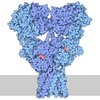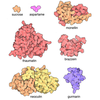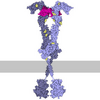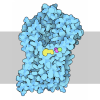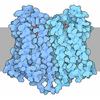+ Open data
Open data
- Basic information
Basic information
| Entry | Database: PDB / ID: 9oou | |||||||||
|---|---|---|---|---|---|---|---|---|---|---|
| Title | Glycine/Glutamate/EU 1622-240 rGluN1a-2B NMDAR | |||||||||
 Components Components | (Glutamate receptor ionotropic, NMDA ...) x 2 | |||||||||
 Keywords Keywords | MEMBRANE PROTEIN / Ion Channels / NMDAR | |||||||||
| Function / homology |  Function and homology information Function and homology informationcellular response to curcumin / cellular response to corticosterone stimulus / cellular response to magnesium starvation / sensory organ development / pons maturation / positive regulation of Schwann cell migration / regulation of cell communication / sensitization / EPHB-mediated forward signaling / Assembly and cell surface presentation of NMDA receptors ...cellular response to curcumin / cellular response to corticosterone stimulus / cellular response to magnesium starvation / sensory organ development / pons maturation / positive regulation of Schwann cell migration / regulation of cell communication / sensitization / EPHB-mediated forward signaling / Assembly and cell surface presentation of NMDA receptors / response to hydrogen sulfide / auditory behavior / olfactory learning / conditioned taste aversion / dendritic branch / regulation of respiratory gaseous exchange / response to other organism / protein localization to postsynaptic membrane / regulation of ARF protein signal transduction / fear response / apical dendrite / transmitter-gated monoatomic ion channel activity / positive regulation of inhibitory postsynaptic potential / suckling behavior / response to methylmercury / response to manganese ion / response to glycine / propylene metabolic process / response to carbohydrate / interleukin-1 receptor binding / cellular response to dsRNA / response to growth hormone / cellular response to lipid / negative regulation of dendritic spine maintenance / heterocyclic compound binding / positive regulation of glutamate secretion / regulation of monoatomic cation transmembrane transport / RAF/MAP kinase cascade / NMDA glutamate receptor activity / Synaptic adhesion-like molecules / voltage-gated monoatomic cation channel activity / response to glycoside / NMDA selective glutamate receptor complex / glutamate binding / ligand-gated sodium channel activity / neurotransmitter receptor complex / response to morphine / regulation of axonogenesis / neuromuscular process / calcium ion transmembrane import into cytosol / regulation of dendrite morphogenesis / protein heterotetramerization / male mating behavior / regulation of synapse assembly / glycine binding / response to amine / regulation of cAMP/PKA signal transduction / small molecule binding / parallel fiber to Purkinje cell synapse / receptor clustering / startle response / positive regulation of reactive oxygen species biosynthetic process / monoatomic cation transmembrane transport / behavioral response to pain / regulation of MAPK cascade / positive regulation of calcium ion transport into cytosol / regulation of postsynaptic membrane potential / response to magnesium ion / cellular response to glycine / associative learning / action potential / extracellularly glutamate-gated ion channel activity / excitatory synapse / response to electrical stimulus / positive regulation of dendritic spine maintenance / monoatomic cation transport / social behavior / regulation of neuronal synaptic plasticity / monoatomic ion channel complex / glutamate receptor binding / Unblocking of NMDA receptors, glutamate binding and activation / positive regulation of excitatory postsynaptic potential / long-term memory / detection of mechanical stimulus involved in sensory perception of pain / response to mechanical stimulus / synaptic cleft / neuron development / behavioral fear response / prepulse inhibition / phosphatase binding / multicellular organismal response to stress / positive regulation of synaptic transmission, glutamatergic / postsynaptic density, intracellular component / monoatomic cation channel activity / calcium ion homeostasis / response to fungicide / glutamate-gated receptor activity / cell adhesion molecule binding / regulation of neuron apoptotic process / regulation of long-term synaptic depression Similarity search - Function | |||||||||
| Biological species |  | |||||||||
| Method | ELECTRON MICROSCOPY / single particle reconstruction / cryo EM / Resolution: 3.34 Å | |||||||||
 Authors Authors | Steigerwald, R. / Furukawa, H. | |||||||||
| Funding support |  United States, 2items United States, 2items
| |||||||||
 Citation Citation |  Journal: To Be Published / Year: 2025 Journal: To Be Published / Year: 2025Title: Mechanism of conductance control and neurosteroid binding in NMDA receptors Authors: Steigerwald, R. / Furukawa, H. | |||||||||
| History |
|
- Structure visualization
Structure visualization
| Structure viewer | Molecule:  Molmil Molmil Jmol/JSmol Jmol/JSmol |
|---|
- Downloads & links
Downloads & links
- Download
Download
| PDBx/mmCIF format |  9oou.cif.gz 9oou.cif.gz | 372.6 KB | Display |  PDBx/mmCIF format PDBx/mmCIF format |
|---|---|---|---|---|
| PDB format |  pdb9oou.ent.gz pdb9oou.ent.gz | Display |  PDB format PDB format | |
| PDBx/mmJSON format |  9oou.json.gz 9oou.json.gz | Tree view |  PDBx/mmJSON format PDBx/mmJSON format | |
| Others |  Other downloads Other downloads |
-Validation report
| Summary document |  9oou_validation.pdf.gz 9oou_validation.pdf.gz | 1.8 MB | Display |  wwPDB validaton report wwPDB validaton report |
|---|---|---|---|---|
| Full document |  9oou_full_validation.pdf.gz 9oou_full_validation.pdf.gz | 1.8 MB | Display | |
| Data in XML |  9oou_validation.xml.gz 9oou_validation.xml.gz | 72.6 KB | Display | |
| Data in CIF |  9oou_validation.cif.gz 9oou_validation.cif.gz | 104.6 KB | Display | |
| Arichive directory |  https://data.pdbj.org/pub/pdb/validation_reports/oo/9oou https://data.pdbj.org/pub/pdb/validation_reports/oo/9oou ftp://data.pdbj.org/pub/pdb/validation_reports/oo/9oou ftp://data.pdbj.org/pub/pdb/validation_reports/oo/9oou | HTTPS FTP |
-Related structure data
| Related structure data |  70673MC M: map data used to model this data C: citing same article ( |
|---|---|
| Similar structure data | Similarity search - Function & homology  F&H Search F&H Search |
- Links
Links
- Assembly
Assembly
| Deposited unit | 
|
|---|---|
| 1 |
|
- Components
Components
-Glutamate receptor ionotropic, NMDA ... , 2 types, 4 molecules ACBD
| #1: Protein | Mass: 95225.883 Da / Num. of mol.: 2 Mutation: N61Q, N239D, N350Q, N471Q, N491Q, N771Q, R844Q, R845G, K846A Source method: isolated from a genetically manipulated source Source: (gene. exp.)   #2: Protein | Mass: 96498.977 Da / Num. of mol.: 2 Source method: isolated from a genetically manipulated source Source: (gene. exp.)   |
|---|
-Non-polymers , 4 types, 26 molecules 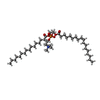
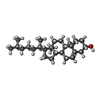
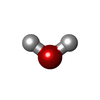


| #3: Chemical | | #4: Chemical | ChemComp-A1AFT / ( Mass: 478.310 Da / Num. of mol.: 4 / Source method: obtained synthetically / Formula: C20H14BrF2N3O2S / Feature type: SUBJECT OF INVESTIGATION #5: Chemical | #6: Water | ChemComp-HOH / | |
|---|
-Details
| Has ligand of interest | Y |
|---|---|
| Has protein modification | Y |
-Experimental details
-Experiment
| Experiment | Method: ELECTRON MICROSCOPY |
|---|---|
| EM experiment | Aggregation state: CELL / 3D reconstruction method: single particle reconstruction |
- Sample preparation
Sample preparation
| Component | Name: Di-heteromeric GluN1a-2B NMDA receptor / Type: CELL / Entity ID: #1-#2 / Source: NATURAL |
|---|---|
| Source (natural) | Organism:  |
| Buffer solution | pH: 7.5 |
| Specimen | Embedding applied: NO / Shadowing applied: NO / Staining applied: NO / Vitrification applied: YES |
| Vitrification | Cryogen name: ETHANE |
- Electron microscopy imaging
Electron microscopy imaging
| Experimental equipment |  Model: Titan Krios / Image courtesy: FEI Company |
|---|---|
| Microscopy | Model: TFS KRIOS |
| Electron gun | Electron source:  FIELD EMISSION GUN / Accelerating voltage: 300 kV / Illumination mode: FLOOD BEAM FIELD EMISSION GUN / Accelerating voltage: 300 kV / Illumination mode: FLOOD BEAM |
| Electron lens | Mode: BRIGHT FIELD / Nominal defocus max: 2200 nm / Nominal defocus min: 600 nm |
| Image recording | Electron dose: 58.4 e/Å2 / Film or detector model: GATAN K3 BIOQUANTUM (6k x 4k) |
- Processing
Processing
| EM software |
| ||||||||||||||||||||||||
|---|---|---|---|---|---|---|---|---|---|---|---|---|---|---|---|---|---|---|---|---|---|---|---|---|---|
| CTF correction | Type: PHASE FLIPPING AND AMPLITUDE CORRECTION | ||||||||||||||||||||||||
| Symmetry | Point symmetry: C2 (2 fold cyclic) | ||||||||||||||||||||||||
| 3D reconstruction | Resolution: 3.34 Å / Resolution method: FSC 0.143 CUT-OFF / Num. of particles: 382882 / Symmetry type: POINT | ||||||||||||||||||||||||
| Refinement | Highest resolution: 3.34 Å Stereochemistry target values: REAL-SPACE (WEIGHTED MAP SUM AT ATOM CENTERS) | ||||||||||||||||||||||||
| Refine LS restraints |
|
 Movie
Movie Controller
Controller



 PDBj
PDBj